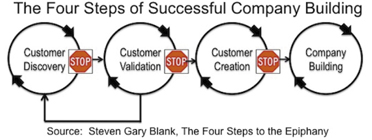
Why you should apply Lean Startup Methodologies to your existing business?
Eric Ries first used the term “Lean Startup” in a post on his blog on September 8, 2008. This post was both the genesis of the lean startup movement and the culmination of a number of years of mentoring and research. The impetus for Eric’s exploration was a string of recent failures in his high tech startups. He was determined to find a better way. In his postmortems, he discovered Lean.
The essence of a Lean Startup is the collision of business development with the tenets of lean manufacturing. This collision and the resulting mashup took a century to develop. The roots of lean manufacturing date back to Henry Ford and the introduction of the assembly line in 1907. Ford’s intent was to realize maximum efficiency in labor and materials by aligning highly efficient process flows. Lean is efficiency.
Forty years later in 1947 W.E. Deming would lecture a group of post-war Japanese industrialists, proposing that improving quality reduces expenses and increases productivity. Fast forward to the ‘80s and we find Sony and Toyota dominating global production and distribution. In Japan, Deming is a national hero. Lean is quality.
Finally to the present, the mashup defined: “Building high quality products is at the heart of what makes lean work. Our intuition as human beings is that going slower gets to higher quality outcomes and helps us learn faster; that is just a broken intuition that is factually not true. We cannot necessarily pull from what customers say they want, we have to pull also from our hypothesis about “what” customers “might” want. That is what quality looks like in entrepreneurship,” according to Ries, author of The Lean Startup at SXSW 2012.
Applying Lean
Before we can define and apply lean methodologies, we need to define product. A product is a good, a service, an experience or ideally all three at once (think iPad or Pinterest). We must also embrace the marketing concept, which mandates that all products are customer driven, fulfilling your customer’s needs, wants and demands. The most successful products also create desire, defined by Kevin Roberts, CEO of Saatchi & Saatchi, as “loyalty beyond reason.”
From the father of management, Peter Drucker offers, “The purpose of business is to create and keep a customer.”
Therefore, in aggregate, “the sole purpose of a business is to create a customer via a product that fulfills their needs, wants and demands and creates desire.” That’s it.
Lean is the process of discovering and delivering this synergy as illustrated by the godfather of the lean startup, Steve Blank, in his Four Steps to Epiphany. 
What Blank is proposing is that we should spend three fourth of our time focused on the assurance that our products are singularly focused on delivering value to our customers; before we build a company to deliver them.
As Marty Neumeier of Liquid Agency and author of The Brand Gap, ZAG, said, “It’s not what you say it is, it’s what they say it is.”
Adopting the Lean Toolkit provides a deliberate pathway to relieving pain and realizing efficiency and profitability. Most importantly it forces you to stop talking about what you are going to do, or should do, and gets you doing what you must do, asking and listening to your customers (i.e. customer validation). It forces you to get out of the building, talk to the right people, change your assumptions and transform your subjective perceptions to objective knowledge.
Lean is a high velocity toolkit to do just that. The Lean Startup methodology is a highly refined modern iterative process distilled from Lean Manufacturing principles, Total Quality Management (TQM), and the Marketing Concept. In addition, it is the convergence of three synergies, a business model canvas (hypothesis), customer development (discovery and validation) and agile product development (minimum viable product).
To discover and apply the power of lean, go to steveblank.com and download a free copy of his Harvard Business Review article, Why the Lean Start-up Changes Everything.
Eric Anthony Spieth is a member of the business faculty at Central Oregon Community College. He received his MBA from Humboldt State University and a bachelor’s in fine arts specializing in digital film and communication design from California State University, Channel Islands. He is also team lead for the COCC | Center for Entrepreneurial Excellence and Design | CEED, an entrepreneurship program focused on and for the community and students interested and committed to taking an idea from concept to launch. The CEED program will relocate from the Bend Campus to the new Redmond Technology Education Center in Fall 2014.





